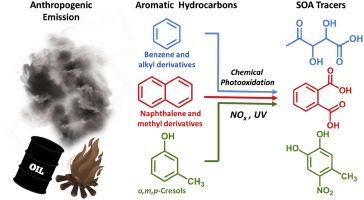当前位置:
X-MOL 学术
›
Atmos. Environ.
›
论文详情
Our official English website, www.x-mol.net, welcomes your
feedback! (Note: you will need to create a separate account there.)
Secondary organic aerosols from aromatic hydrocarbons and their contribution to fine particulate matter in Atlanta, Georgia
Atmospheric Environment ( IF 4.2 ) Pub Date : 2020-02-01 , DOI: 10.1016/j.atmosenv.2019.117227 Ibrahim M. Al-Naiema , John H. Offenberg , Carter J. Madler , Michael Lewandowski , Josh Kettler , Ting Fang , Elizabeth A. Stone
Atmospheric Environment ( IF 4.2 ) Pub Date : 2020-02-01 , DOI: 10.1016/j.atmosenv.2019.117227 Ibrahim M. Al-Naiema , John H. Offenberg , Carter J. Madler , Michael Lewandowski , Josh Kettler , Ting Fang , Elizabeth A. Stone

|
Tracers of secondary organic aerosols (SOA) from thirteen aromatic hydrocarbons were quantified in laboratory smog chamber experiments. Class-specific SOA tracers emerged, including 2,3-dihydroxy-4-oxo-pentatonic acid (DHOPA) from monoaromatic volatile organic compounds (VOCs), phthalic acid from naphthalene and 1-methylnaphthalene, and methyl-nitrocatechol isomers from o,m,p-cresol oxidation. Organic carbon mass fractions (fSOC) for these and other tracers were determined and extend the SOA tracer method widely used to apportion biogenic SOC. The extended SOA tracer model was applied to evaluate the sources of SOC in Atlanta, GA during summer 2015 and winter 2016 after modifying the chamber-derived fSOC values to reflect SOA yields and local VOC levels (fSOC'). Monoaromatic, diaromatic, and cresol SOC contributed an average of 24%, 8%, and 0.12% of organic carbon (OC) mass during summer and 17%, 5%, and 0.27% during winter, respectively. Cresol SOC peaked during winter and was highly correlated with levoglucosan (r=0.83, p<0.001), consistent with it originating from biomass burning. Together, aromatic, biogenic, and biomass burning derived SOC accounted for an average of 77% and 28% of OC in summer and winter, respectively. The new understanding of SOA composition from aromatic VOCs advances the tracer-based method by including important precursors of SOC and enables a better understanding of the sources of atmospheric aerosol.
中文翻译:

佐治亚州亚特兰大市芳烃二次有机气溶胶及其对细颗粒物的贡献
在实验室烟雾室实验中量化了来自 13 种芳烃的二次有机气溶胶 (SOA) 示踪剂。出现了特定类别的 SOA 示踪剂,包括来自单芳族挥发性有机化合物 (VOC) 的 2,3-二羟基-4-氧代五糖酸 (DHOPA)、来自萘和 1-甲基萘的邻苯二甲酸以及来自 o,m 的甲基-硝基儿茶酚异构体,对甲酚氧化。确定了这些和其他示踪剂的有机碳质量分数 (fSOC),并扩展了广泛用于分配生物 SOC 的 SOA 示踪剂方法。2015 年夏季和 2016 年冬季,在修改腔室衍生的 fSOC 值以反映 SOA 产量和局部 VOC 水平 (fSOC') 后,扩展的 SOA 示踪模型用于评估佐治亚州亚特兰大 SOC 的来源。单芳香族、双芳香族和甲酚 SOC 平均贡献了 24%、8% 和 0。夏季有机碳 (OC) 质量的 12% 和冬季分别为 17%、5% 和 0.27%。甲酚 SOC 在冬季达到峰值,并且与左旋葡聚糖高度相关(r=0.83,p<0.001),与其来源于生物质燃烧一致。夏季和冬季,芳香、生物和生物质燃烧产生的 SOC 分别占 OC 的平均 77% 和 28%。对来自芳香族 VOC 的 SOA 成分的新理解通过包括 SOC 的重要前体推进了基于示踪剂的方法,并能够更好地了解大气气溶胶的来源。夏季和冬季,芳香、生物和生物质燃烧产生的 SOC 分别占 OC 的平均 77% 和 28%。对来自芳香族 VOC 的 SOA 成分的新理解通过包括 SOC 的重要前体推进了基于示踪剂的方法,并能够更好地了解大气气溶胶的来源。夏季和冬季,芳香、生物和生物质燃烧产生的 SOC 分别占 OC 的平均 77% 和 28%。对来自芳香族 VOC 的 SOA 成分的新理解通过包括 SOC 的重要前体推进了基于示踪剂的方法,并能够更好地了解大气气溶胶的来源。
更新日期:2020-02-01
中文翻译:

佐治亚州亚特兰大市芳烃二次有机气溶胶及其对细颗粒物的贡献
在实验室烟雾室实验中量化了来自 13 种芳烃的二次有机气溶胶 (SOA) 示踪剂。出现了特定类别的 SOA 示踪剂,包括来自单芳族挥发性有机化合物 (VOC) 的 2,3-二羟基-4-氧代五糖酸 (DHOPA)、来自萘和 1-甲基萘的邻苯二甲酸以及来自 o,m 的甲基-硝基儿茶酚异构体,对甲酚氧化。确定了这些和其他示踪剂的有机碳质量分数 (fSOC),并扩展了广泛用于分配生物 SOC 的 SOA 示踪剂方法。2015 年夏季和 2016 年冬季,在修改腔室衍生的 fSOC 值以反映 SOA 产量和局部 VOC 水平 (fSOC') 后,扩展的 SOA 示踪模型用于评估佐治亚州亚特兰大 SOC 的来源。单芳香族、双芳香族和甲酚 SOC 平均贡献了 24%、8% 和 0。夏季有机碳 (OC) 质量的 12% 和冬季分别为 17%、5% 和 0.27%。甲酚 SOC 在冬季达到峰值,并且与左旋葡聚糖高度相关(r=0.83,p<0.001),与其来源于生物质燃烧一致。夏季和冬季,芳香、生物和生物质燃烧产生的 SOC 分别占 OC 的平均 77% 和 28%。对来自芳香族 VOC 的 SOA 成分的新理解通过包括 SOC 的重要前体推进了基于示踪剂的方法,并能够更好地了解大气气溶胶的来源。夏季和冬季,芳香、生物和生物质燃烧产生的 SOC 分别占 OC 的平均 77% 和 28%。对来自芳香族 VOC 的 SOA 成分的新理解通过包括 SOC 的重要前体推进了基于示踪剂的方法,并能够更好地了解大气气溶胶的来源。夏季和冬季,芳香、生物和生物质燃烧产生的 SOC 分别占 OC 的平均 77% 和 28%。对来自芳香族 VOC 的 SOA 成分的新理解通过包括 SOC 的重要前体推进了基于示踪剂的方法,并能够更好地了解大气气溶胶的来源。











































 京公网安备 11010802027423号
京公网安备 11010802027423号